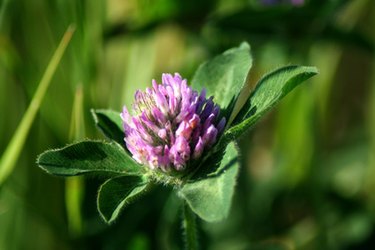
The red clover plant (Trifolium pratense, USDA zones 3-9) is used as forage, soil improvement and cover crop. Red clover lives only two years, growing quickly in spring and subsiding in winter. As a forage crop, red clover is seeded in spring sometimes alone and sometimes with a companion crop such as oats. To use red clover as a cover crop, the plant is sown in late summer or early fall. Red clover is seeded in late winter to early spring in most areas where soil improvement is required.
Red Clover Description
Video of the Day
Red clover can grow prostrate or upright and grows 18 to 36 inches tall. The leaves are trifoliate, marked with a white V and borne on stems that have fine little hairs. The flowers are actually clusters of tiny individual flowers that can number from 75 to 125. The flower color is actually more purple to pink than red. The plant has a long, deep taproot that helps it anchor in poor soils.
Video of the Day
There are two main varieties: mammoth and medium. The medium red clover is most often planted in the United States.
Nitrogen Fixing Properties
Red clover is often used as a nitrogen fixer and to enhance soils where excess cropping has drained the nutrient. Red clover has a taproot that is up to 36 inches long. The root has peripheral roots that grow pinkish nodules that fix nitrogen.
When it is seeded as a nitrogen fixer, red clover is often inoculated with Rhizobium trifolii, which helps the plant form the nitrogen nodules on its roots. Red clover is a legume, and all the members of this family can collect and store nitrogen. It is released when the clover is tilled into the ground.
Clover Planting Information
Red clover seed is shaped like a tiny mitten. The sowing time depends on what use the plant will be put to. The type of soil is not terribly important, but the clover prefers acidic media. The plant performs best in soils with high levels of phosphorus and potassium. Red clover can be sown by broadcast, band seeding and fluid seeding. The home gardener can use a seed spreader and broadcast the seed over a tilled or non-tilled bed.
Timing for Different Uses
Red clover provides grazing material and harvested forage when planted in spring after the last frost. The plant is harvested at pre-bloom or when in full bloom. Most clover stands are harvested twice in summer and once more in fall. If the crop is not harvested in the fall, it can be used as a nitrogen-fixing crop and become incorporated into the soil. A winter red clover cover crop protects soils from erosion and wind sweep that can remove important topsoils.
In temperate zones, red clover is seeded in early fall to provide coverage. Late winter sowing is useful as tillage for some spring crops; although the plant may not have enough time to store nitrogen, it will increase the tilth of the soil with its long taproots.